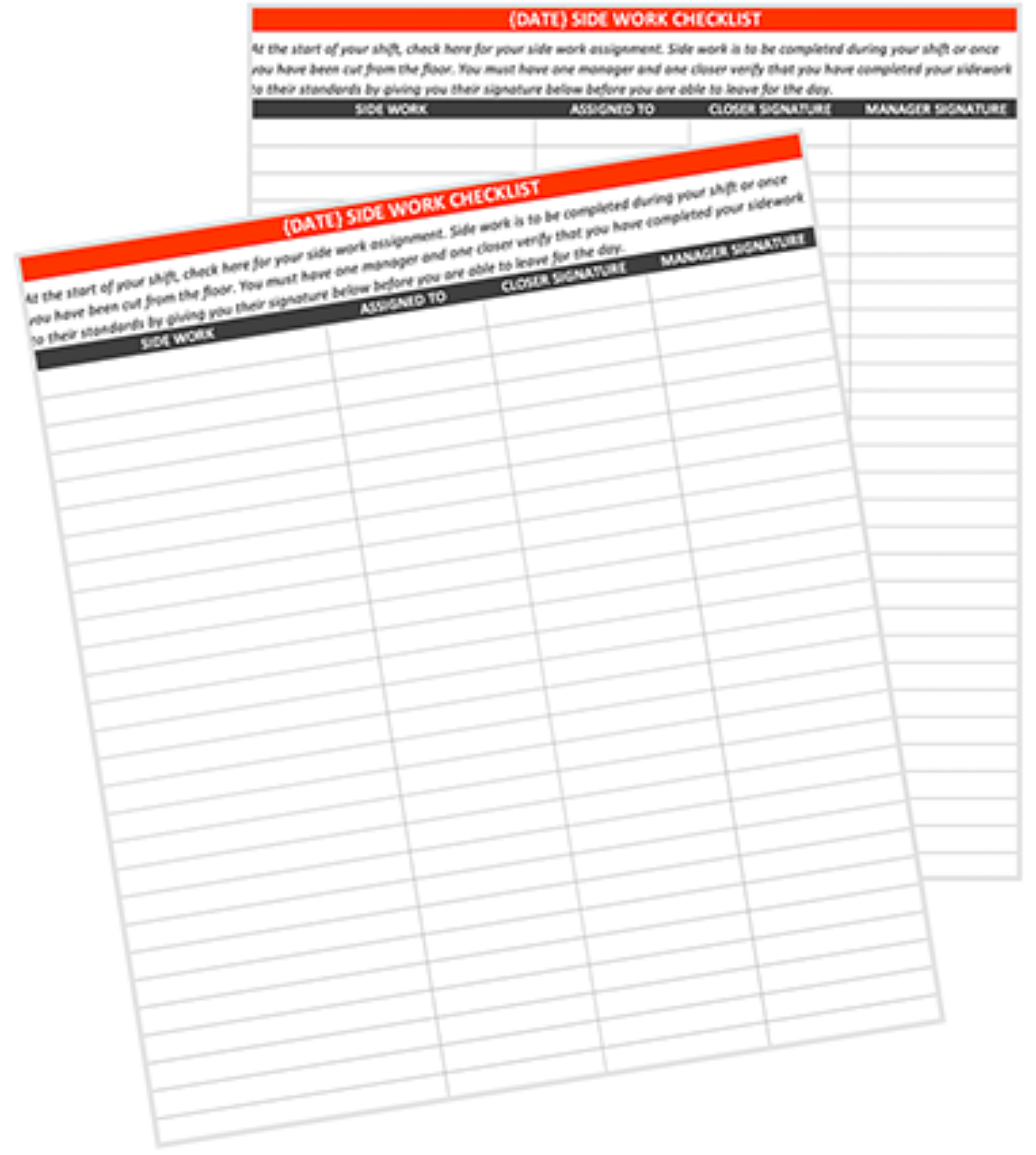
Train Your Team With a Server Side Work Checklist
Keeping everyone accountable just got easier.

Isabelle HahnAuthor


Server Side Work Checklist Template
This Excel document template will help you create a Server Side Work Checklist for your restaurant — and train staff more effectively.
Get free downloadWho wants to work at a restaurant with dirty silverware or no glasses? Who can make tips when a dining room is covered in years of dust? Who wants to finish their meal with a check presenter smeared with the fingerprints of past clients?
Nobody, according to Rose Bernhard, a server at Peter Havens in Brattleboro, Vermont. "Side work is the skin of any restaurant," she said. "It holds everything together."
So what is side work, exactly? Server side work consists of chore-like restaurant operations assigned to each front-of-house member to be completed before the end of their scheduled shift. Side work focuses your servers on details like restocking supplies, cleaning menus, or filling salt shakers, so you can provide a better dining experience to every guest who sets foot in your establishment.
Your side work checklist acts as an agenda or to-do list for your front-of-house employees, similar to an opening and closing checklist for your restaurant. With a checklist, your staff knows what needs to be done without being told — which means no more checking in before, during, or after their shifts to see what work’s been completed (or not).
Checklists effectively help restaurant management streamline to-do lists, prevent staff from overlooking tasks, and reduce labor costs.
According to a study published in the New England Journal of Medicine, checklists can also decrease human error — in one example, the use of checklists in surgical settings was associated with a 47% reduction in the rate of death and complications.
Even if you aren't performing open-heart surgery, checklists can still keep your staff accountable — especially when it comes to the more tedious parts of their job.
Server Side Work Checklist Template
This Excel document template will help you create a Server Side Work Checklist for your restaurant — and train staff more effectively.

How to Make a Server Side Work Checklist
A side work checklist template doesn’t have to be an exquisitely designed piece of branding material, but it does need to be clear and easy to use. We recommend having a basic template you can return to week after week, so you don’t have to draw up a new checklist every Sunday before the first shift of the week begins. Here is a free restaurant side work checklist to get you started.
Tasks to include
To start, outline the side work duties that need to be completed. Be specific — start with one particular area, like tabletop presentation. After that, work your way around the restaurant to create a master list of tasks. Here are some examples:
Table work
Wipe down all chairs/booths
Clean tables
Sweep under all tables
Set tables
Refill salt, pepper, condiments, and/or sweeteners
Restock napkins
Re-light candles
Straighten table tents
Behind-the-scenes work
Sanitize counters
Clean around the restaurant’s POS system
Refill POS receipt paper
Stock the drink station with cups, lids, and straws
Wipe down windows
Tidy up menus
Bring in the umbrellas
Clean out the coffee station
Polish flatware
Restock server station with clean dishes
Not occupied? Lend a hand elsewhere
Assist other servers and bussers with their table or running.
If you have a large party coming in, start re-arranging the tables.
Help the host(ess) with seating if there’s a line out the front door.
See if the bartenders need fresh bar garnishes
Ask back-of-house staff if they need something prepped or garnished.
Help bring takeout out from the kitchen
Clean up other sections, especially if their server is busy.
Format your list
Now that you’ve listed all your tasks, you should check the formatting of your list.
Check for online templates to see if anyone has done the heavy lifting for you. (Intouch Insight offers a great template you can use to get started.)
Combine similar steps or actions — or simplify complex tasks by breaking out essential steps.
Give your list a test run to see if things are in a logical order.
Consider where a server needs this checklist kept. Maybe laminating it so they can write over it and then clean it off each day is best.
Refine your checklist.
Keep things simple. Atul Gawande, M.D., author of "The Checklist Manifesto," says, "A good checklist is precise, efficient, and easy to use, even in the most difficult situations." In other words, you don't need pages on how to refill a ketchup bottle.
Be open to feedback. If your servers have questions, comments, or ideas, make time to listen. After all, they’re the ones doing the work. You can also gain ideas from new servers that came from different restaurants.
Rinse, repeat, and refine. Think of improving your side work checklist as part of your monthly side work. If you left something off, go back and add it. If something isn’t logical, rethink it. Checklists can be updated easily, and can be a great tool — as long as you put in the effort.
Make side work one of your main tasks of server training. This way new hires still set their team up for success even on their first training session.
Restaurant Opening and Closing Checklist
The beginning and end of a shift can be frantic. Use this free PDF checklist to set your front-of-house staff up for success.

Servers Weigh in on Side Work
“I was really horrible at doing side work,” said Erin Rupert, who’s been a server at multiple restaurants. “When I served at Buzz’s Steakhouse in Kailua, there was a massive side work checklist.”
Buzz’s was a fine dining restaurant, so there were many important side work tasks, including polishing the silverware when it came out of the dishwasher. This task was critical to ensuring guests wouldn’t see streaks on their utensils.
“Some people would sit and chill outside in the parking lot, we’d be busy, and I’d have to scour the restaurant for a fork to use for the next table,” Rupert said. “I think the side work checklist works because if you aren’t doing it, nobody else is going to do it. Side work isn’t fun, but everyone needs to be held accountable.”
Shaina Richards has been a server at three restaurants, and each handled side work differently. At one, there was no checklist and zero accountability for who was doing what task, so side work got competitive. Eventually, management instituted a policy that only servers who were cut for the night could do certain side work tasks — which meant that you could be cut at 8 p.m. and still be polishing silverware at 11 p.m.
“Sometimes servers would finish polishing just to leave for a second and find that someone stole their completed side work to put in their section and take credit for it,” Richards explained. “It was just a very toxic process and people would end up fighting over it all the time.”
By adopting a checklist, you create transparency among staff, servers, and management alike, so that everyone who gets their work done gets proper credit.
“I don’t hate or resent side work. I do resent people who leave without completing their assigned section. I consider it selfish,” Richards said. “Why push your responsibilities onto someone else? It also quickly reveals who’s a team player and who is not.”
Keeping Your Staff in Mind
A great side work checklist will make your servers' lives easier and make your food service go smoother. By putting it in writing, you tell your team what you'd like them to prioritize and provide them a space to track progress. Servers can use the list to predict your needs and meet them quickly and efficiently — all during their scheduled shift.
The ideal side work checklist will also be unique to your restaurant. You know how your team likes to get things done, so create a template that will work for them as well as it does for you.
Drawing the Side Work Line
While side work is, in most cases, considered part of the job, it shouldn’t be the whole job. According to USA Employment Lawyers, performing more than 30 minutes of continuous side work at a restaurant can lead to wage violations under Federal and State Law. In fact, the Department of Labor entered a mandate requiring restaurants to pay their servers and bartenders the full minimum wage (no tip credit can be taken from the employee’s pay) if the servers or bartenders spend more than 30 continuous minutes performing any of the side work mentioned above. This proves that having a checklist with work spread throughout your front-of-house team is a restaurant's best practice.
If you expect your servers to perform side work, you should be open about it during the hiring and onboarding process. Side work may not come as a surprise for seasoned restaurant workers, but it might be something newbies haven’t encountered before. As long as you set the tone up front and keep side work simple, straightforward, and within reason, you’ll have a happy staff willing to pitch in and fill the condiment bottles.
Is this article helpful?
DISCLAIMER: This information is provided for general informational purposes only, and publication does not constitute an endorsement. Toast does not warrant the accuracy or completeness of any information, text, graphics, links, or other items contained within this content. Toast does not guarantee you will achieve any specific results if you follow any advice herein. It may be advisable for you to consult with a professional such as a lawyer, accountant, or business advisor for advice specific to your situation.
Read More
Subscribe to On the Line
Sign up to get industry intel, advice, tools, and honest takes from real people tackling their restaurants’ greatest challenges.



